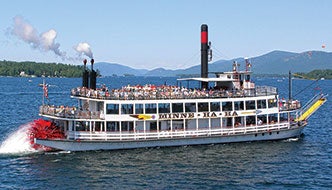
The Minne-Ha-Ha, a paddle-wheel steamboat and Lake George icon, is now playing a role in the Jefferson Project by carrying an Acoustic Doppler Current Profiler to track the direction and speed of particles suspended in the water.
For more than a year, the Jefferson Project at Lake George has been collecting electronic data from sensors mounted in stream beds, platforms moored on the water, and in the depths of the lake bottom. A tour boat plying the southern basin of the lake may be an unexpected next step for sensor deployments, but it’s actually an ideal perch for scientific instrumentation, according to researchers Mike Kelly and Jeremy Farrell.
A few weeks ago, the Jefferson Project bolted an Acoustic Doppler Current Profiler (ADCP) to the starboard side of the Minne-Ha-Ha, a paddle-wheel steamboat and Lake George icon owned by the Lake George Steamboat Company. An ADCP employs techniques similar to active sonar to track the direction and speed of particles suspended in the water, providing information on water circulation within the lake. Researchers also plan to use the instrument’s backscatter data to track the volume and movement of zooplankton in the lake. The Minne-Ha-Ha, which in summer months circles the southern two miles of Lake George in seven daily cruises, passes several features of scientific interest, and does so slowly and predictably enough to gather data in its path.
The Acoustic Doppler Current Profiler on the Minne-Ha-Ha will give us information on aspects of the lake that would have been far more difficult to understand with stationary sensors.”—Mike Kelly
The Jefferson Project—a partnership between Rensselaer, IBM Research, and The FUND for Lake George—combines Internet of Things (IoT) sensor platforms with surveying and experimentation to better understand Lake George. This is a new model in environmental monitoring, a critical element of which is the IoT network of sensors—able to communicate with one another, researchers, and supercomputers—that monitor chemical and physical parameters related to weather, water runoff, water circulation, and water quality. The incoming data fuel a series of computer models depicting the lake’s weather, runoff, circulation, and, ultimately, food web of the lake, with the goal of understanding how human activity impacts the ecology of Lake George.

Mike Kelly, IBM senior research engineer, makes final preparations to the ADCP head prior
to mounting it on the hull.
Measurements taken along the Minne-Ha-Ha’s path can provide invaluable information about the Caldwell Basin—the southernmost sub-basin of Lake George—said Kelly, an IBM senior research engineer. The ship crosses the mouths of three of the largest tributaries into the lake and can gather data on how incoming waters mix within the southern basin.
It also passes one of the projects vertical profilers—a stationary, floating sensor platform that monitors weather and multiple aspects of water chemistry and quality at varying depths—and data from the two sources taken together provides a more complex, robust view of conditions in the area over time.
“To me, any single piece of the picture this will provide would be a sufficiently compelling reason to do this, and when you put everything together, this has enormous potential for advancing our understanding of the south end of the lake,” said Kelly. “The ADCP on the Minne-Ha-Ha will give us information on aspects of the lake that would have been far more difficult to understand with stationary sensors.”
Researchers are also experimenting with the potential for tracking zooplankton using ADCP data, an application driven by Farrell, a postdoctoral researcher working under Sandra Nierzwicki-Bauer, director of the Darrin Fresh Water Institute. In December 2014, Jefferson Project researchers lowered three ADCPs to the lakebed, leaving them to collect data for five months. When the researchers reviewed the data, biologists Farrell and Nierzwicki-Bauer noticed a striking pattern that coincides with the diurnal vertical migration of zooplankton.
According to Farrell, during daylight hours, zooplankton inhabit the deeper waters of the lake, where, in the darkness, it is believed that they are less likely to be seen by predators. At night, the tiny animals rise closer to the surface of the lake to feed on phytoplankton. Although this phenomenon is well known, and can be observed by hand-harvesting plankton at various times and depths, the ADCP data can amplify those efforts to provide abundant and immediate information on the volume and movements of zooplankton.


